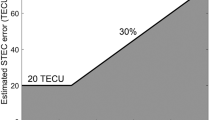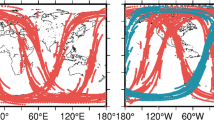Abstract
The BeiDou-3 system uses the BeiDou Global broadcast Ionospheric delay correction Model (BDGIM) to describe global vertical total electron content (VTEC) distributions and provide ionospheric delay mitigations in single-frequency positioning. The transmission of BDGIM correction parameters in the navigation message of BeiDou-3 started in mid-2015. The limited coverage of BeiDou-3 transmitted BDGIM parameters inhibits the evaluation of model performance during different levels of solar conditions. As such, we present a method to re-estimate BDGIM correction parameters and generate model parameters during the period 2010–2017 using a small global network of 20 global navigation satellite system (GNSS) stations. Tests covering the eight years demonstrate that BDGIM can reduce the ionospheric error to less than 25% for 98% of the examined samples when compared to global ionospheric maps (GIMs) provided by the International GNSS Service (IGS), and for 90% when compared to the observed VTECs from Jason-2/3 altimetry missions. Overall, BDGIM reduces residual ionospheric delays by 10–20% compared to the ionospheric correction algorithm (ICA) of the global positioning system (GPS), the empirical International Reference Ionosphere (IRI) 2016, and our fitted NeQuick-C model. The root-mean-square (RMS) error of BDGIM increases by 32 and 21% in comparison with GIM-derived and Jason-2 observed VTECs during the geomagnetic storm in March 2015, indicating the significant degradation of model performance during the disturbed geomagnetic period.













Similar content being viewed by others
Explore related subjects
Discover the latest articles, news and stories from top researchers in related subjects.References
Bilitza D, Altadill D, Truhlik V, Shubin V, Galkin I, Reinisch B, Huang X (2017) International reference ionosphere 2016: from ionospheric climate to real-time weather predictions. Space Weather 15(2):418–429
CSNO (2017a) BeiDou navigation satellite system signal in space interface control document – open service signal B1C (Version 1.0). China Satellite Navigation Office, Dec 2017
CSNO (2017b) BeiDou navigation satellite system signal in space interface control document – open service signal B2a (Version 1.0). China Satellite Navigation Office, Dec 2017
Hernández-Pajares M, Roma-Dollase D, Krankowski A, García-Rigo A, Orús-Pérez R (2017) Methodology and consistency of slant and vertical assessments for ionospheric electron content models. J Geod 91(12):1405–1414
Hoque MM, Jakowski N (2015) An alternative ionospheric correction model for global navigation satellite systems. J Geod 89(4):391–406
Hoque MM, Jakowski N, Berdermann J (2017) Ionospheric correction using NTCM driven by GPS Klobuchar coefficients for GNSS applications. GPS Solut 21(4):1563–1572
Hoque MM, Jakowski N, Orús-Pérez R (2019) Fast ionospheric correction using Galileo Az coefficients and the NTCM model. GPS Solut. https://doi.org/10.1007/s10291-019-0833-3
Jakowski N, Hoque MM, Mayer C (2011) A new global TEC model for estimating transionospheric radio wave propagation errors. J Geod 85(12):965–974
Klobuchar JA (1987) Ionospheric time-delay algorithm for single-frequency GPS users. IEEE Trans Aero Electron Syst 23(3):325–331
Li Z, Yuan Y, Li H, Ou J, Huo X (2012) Two-step method for the determination of the differential code biases of COMPASS satellites. J Geod 86(11):1059–1076
Montenbruck O, González Rodríguez B (2019) NeQuick-G performance assessment for space applications. GPS Solut. https://doi.org/10.1007/s10291-019-0931-2
Nava B, Coïsson P, Radicella SM (2008) A new version of the NeQuick ionosphere electron density model. J Atmos Sol-terr Phy 70(15):1856–1862
Orus-Perez R, Hernández-Pajares M, Juan J, Sanz J, García-Fernández M (2002) Performance of different TEC models to provide GPS ionospheric corrections. J Atmos Sol-terr Phy 64(18):2055–2062
Orus-Perez R (2016) Ionospheric error contribution to GNSS single-frequency navigation at the 2014 solar maximum. J Geod 91(4):397–407
Orus-Perez R, Parro-Jimenez JM, Prieto-Cerdeira R (2018) Status of NeQuick G after the solar maximum of cycle 24. Radio Sci 53(3):257–268
Prieto-Cerdeira R, Orus-Peres R, Breeuwer E, Lucas-Rodriguez R, Falcone M (2014) Performance of the Galileo single-frequency ionospheric correction during in-orbit validation. GPS World 25(6):53–58
Roma-Dollase D, Hernández-Pajares M, Krankowski A, Kotulak K, Ghoddousi-Fard R, Yuan Y, Li Z, Zhang H, Shi C, Wang C (2018) Consistency of seven different GNSS global ionospheric mapping techniques during one solar cycle. J Geod 92(6):691–706
Wang N, Yuan Y, Li Z, Huo X (2016) Improvement of Klobuchar model for GNSS single-frequency ionospheric delay corrections. Adv Space Res 57(7):1555–1569
Wang N, Yuan Y, Li Z, Montenbruck O, Tan B (2016) Determination of differential code biases with multi-GNSS observations. J Geod 90(3):209–228
Wang N, Yuan Y, Li Z, Li Y, Huo X, Li M (2017) An examination of the Galileo NeQuick model: comparison with GPS and JASON TEC. GPS Solut 21(2):605–615
Wang N, Li Z, Li M, Yuan Y, Huo X (2018) GPS, BDS and Galileo ionospheric correction models: an evaluation in range delay and position domain. J Atmos Sol-terr Phy 170:83–91. https://doi.org/10.1016/j.jastp.2018.02.014
Wang N, Li Z, Huo X, Li M, Yuan Y, Yuan C (2019) Refinement of global ionospheric coefficients for GNSS applications: methodology and results. Adv Space Res 63(1):343–358
Wang N, Li Z, Yuan Y, Li M, Huo X, Yuan C (2019) Ionospheric correction using GPS Klobuchar coefficients with an empirical night-time delay model. Adv Space Res 63(2):886–896
Wang N, Li Z, Montenbruck O, Tang C (2019) Quality assessment of GPS, Galileo and BeiDou-2/3 satellite broadcast group delays. Adv Space Res 64(9):1764–1779
Wang N, Li Z, Duan B, Hugentobler U, Wang L (2020) GPS and GLONASS observable-specific code bias estimation: comparison of solutions from the IGS and MGEX networks. J Geod. https://doi.org/10.1007/s00190-020-01404-5
Wu X, Hu X, Wang G, Zhong H, Tang C (2013) Evaluation of COMPASS ionospheric model in GNSS positioning. Adv Space Res 51(6):959–968
Yang Y, Mao Y, Sun B (2020) Basic performance and future developments of BeiDou global navigation satellite system. Satell Navig. https://doi.org/10.1186/s43020-019-0006-0
Yuan Y, Huo X, Ou J (2005) Development of a new GNSS broadcast ionospheric time delay correction model (IGGSH). In: Proceedings of the International Symposium on GPS/GNSS, December 8–10, Hong Kong
Yuan Y, Huo X, Ou J, Zhang K, Yanju C, Debao W (2008) Refining the Klobuchar ionospheric coefficients based on GPS observations. IEEE Trans Aero Electron Syst 44(4):1498–1510
Yuan Y, Li Z, Huo X, Wang N (2014) A next-generation broadcast model (BDSSH) and its implementation scheme of ionospheric time delay correction for BDS/GNSS. In: Proceedings of the ION GNSS+ 2014, September 8–12, Tampa
Yuan Y, Wang N, Li Z, Huo X (2019) The BeiDou global broadcast ionospheric delay correction model (BDGIM) and its preliminary performance evaluation results. Navigation 66(1):55–69
Zhu Y, Tan S, Zhang Q, Ren X, Jia X (2019) Accuracy evaluation of the latest BDGIM for BDS-3 satellites. Adv Space Res 64(6):1217–1224
Acknowledgments
The authors acknowledge the Crust Movement Observation Network of China (CMONOC) and International GNSS Service (IGS) for providing GNSS data. This work was supported by the National Key Research Program of China (2017YFGH002206), the National Natural Science Foundation of China (42074043), the Alliance of International Science Organizations (ANSO-CR-KP-2020-12), the Youth Innovation Promotion Association and Future Star Program of the Chinese Academy of Sciences. The source codes of BDGIM are available from the first author (wangningbo@aoe.ac.cn) on request.
Author information
Authors and Affiliations
Corresponding author
Additional information
Publisher's Note
Springer Nature remains neutral with regard to jurisdictional claims in published maps and institutional affiliations.
Rights and permissions
About this article
Cite this article
Wang, N., Li, Z., Yuan, Y. et al. BeiDou Global Ionospheric delay correction Model (BDGIM): performance analysis during different levels of solar conditions. GPS Solut 25, 97 (2021). https://doi.org/10.1007/s10291-021-01125-y
Received:
Accepted:
Published:
DOI: https://doi.org/10.1007/s10291-021-01125-y




